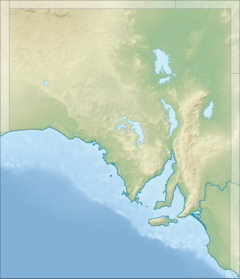| Strzelecki | |
|---|---|
 A map of the Lake Eyre Basin showing the location of Strzelecki Creek | |
Location of the river mouth in South Australia | |
| Etymology | Paul Edmund de Strzelecki |
| Location | |
| Country | Australia |
| State | South Australia |
| Region | Far North |
| Municipality | unincorporated area |
| Physical characteristics | |
| Source | Cooper Creek |
| • location | south of Innamincka |
| • elevation | 52 m (171 ft) |
| Mouth | Lake Blanche |
• location | west of Montecollina |
• coordinates | 29°21′51″S139°49′49″E / 29.364260°S 139.830150°E |
• elevation | 1 m (3 ft 3 in) |
| Length | 200 km (120 mi) |
| Basin features | |
| River system | Lake Eyre Basin |
| protected areas | Strzelecki Regional Reserve |
| [1] | |
The Strzelecki Creek, part of the Lake Eyre basin, is an ephemeral watercourse located in the Australian state of South Australia.
